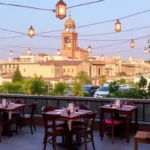Titicaca Lake guide: how to visit and what to see and do

Visiting Lake Titicaca is more than just a trip; it's an unforgettable adventure that immerses you in the rich culture and breathtaking landscapes of Peru and Bolivia. As one of the highest navigable lakes in the world, it offers a unique blend of history, natural beauty, and cultural experiences that travelers simply can't miss. In this comprehensive guide to Lake Titicaca, we’ll explore everything you need to know to make the most of your visit, from legends to practical tips and must-see attractions. Whether you're looking for things to do in Lake Titicaca or simply want to enjoy its stunning views, this guide has you covered.
Essential Information about Lake Titicaca
Are you ready to embark on a journey to one of the most mythical and enchanting places in South America? Let's dive in!
Where is Lake Titicaca Located?
To reach Lake Titicaca, you'll need to travel to either Puno in Peru or Copacabana in Bolivia. While there are several towns along its shores, these cities serve as the ideal bases for exploring the area.
This guide will focus on the Peruvian side of Lake Titicaca, which is rich in attractions, but don't overlook the Bolivian side, particularly the serene town of Copacabana and its stunning Isla del Sol.
Legends Surrounding Lake Titicaca
Lake Titicaca is steeped in captivating myths and legends, the most famous of which relates to the creation of the Inca Empire. According to local lore, the God of creation, Viracocha, was disappointed by humanity's greed and decided to flood the world, sparing only two: Manco Capac, the first Inca emperor, and his sister and wife, Mama Ocllo.
Another tale speaks of a fertile valley surrounding the lake, where men lived under the protection of the Apus, mountain deities. They were forbidden to ascend the mountain where the Sacred Fire was kept, but disobeyed. Enraged, the gods unleashed pumas that feasted on the intruders, leaving only two survivors. Guess who they were?
Curiosities of Lake Titicaca
Beyond its myths, Lake Titicaca boasts some intriguing facts that make it a truly special destination:
- It's the highest navigable lake in the world, situated at nearly 4,000 meters above sea level, with an average depth of 107 meters. However, swimming here can be quite cold, with temperatures ranging from 5-14ºC.
- It is also one of the largest lakes in South America, surpassed only by Lake Maracaibo in Venezuela.
- Home to several floating islands inhabited by the Uros people, who construct these islands from totora, a traditional aquatic plant.
- The island of Taquile, also located in the lake, is renowned for its exceptional textile techniques, making for wonderful souvenirs.
- In 1978, Lake Titicaca was designated a National Reserve, protecting its rich biodiversity. Birdwatchers will delight in spotting numerous species, including the endemic diving duck, wild ducks, and flamingos.
Now, let's delve into the exciting experiences waiting for you on the Peruvian side of Lake Titicaca, including some of the most memorable things to do in Lake Titicaca:
Exploring Puno
Puno, perched on the lake's edge, is the perfect gateway to explore Lake Titicaca (Peru) and serves as a launch point for trips to Bolivia.
Among its attractions, aside from lake tours, are the Plaza de Armas, its magnificent Catedral, colonial houses, and viewpoints overlooking the lake.
⭐ For more information, check out everything to see and do in Puno.
Visiting the Uros Floating Islands
A visit to the Uros Islands is one of the main reasons to come here. These 80 artificial floating islands are crafted from totora through intricate artisanal methods.
Families inhabit these islands and maintain a fascinating cultural heritage, passed down through generations, as long as tourism allows. Keep in mind that this is a heavily touristic destination, so being aware of this can help manage your expectations.
⭐ Here’s our experience on a day tour to the Uros Islands.
Discovering Taquile Island
Taquile Island offers a more leisurely experience on Lake Titicaca. It's best to join a full-day tour that combines visits to the touristy yet fascinating Uros Islands and continues to Taquile, the largest island in the lake.
Taquile is famous for being home to one of the best weaving communities in the world, recognized by UNESCO as a Cultural Heritage of Humanity.
⭐ For more details on this tour, check out this link.
Experiencing Amantaní Island
If you have extra time, consider a 2-day tour that includes a night spent with a local family on Amantaní Island. This immersive experience allows you to dive deep into local culture.
You’ll not only visit the Uros and Taquile Islands but also enjoy the tranquil beauty of Amantaní, where local families welcome you into their homes. This is a chance to savor home-cooked meals and experience the genuine hospitality of the islanders.
⭐ For more information on this tour, visit this page.
As we wrap up this guide, we hope it has provided valuable insights and inspiration for your visit to the unique and magical Lake Titicaca. Have you been? Do you know more things to see and do at Lake Titicaca? If so, make sure to share your experiences and tips.
Stay updated on our journey in Peru through our Instagram stories.
For those planning their trip, here’s a handy table with tips on saving during your travels:
| Save on your trip |
| Get cheap flights to Peru here |
| Find accommodation at the best prices here |
| Book activities in Spanish in Peru here |
| 5% discount on your travel insurance IATI here |
| Reserve transfers from the airport here |
| Find out how to withdraw money without fees here |
| 5% discount on your eSIM from Holafly here |
| Rent a car with the best deals here |
| The best books and travel guides here |
| All our articles about Peru |



Deja una respuesta